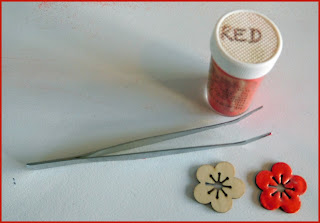Playing with paper - a technique a week for those who enjoy the journey as well as the destination!
Friday, 23 November 2018
Saturday, 20 October 2018
Saturday, 15 September 2018
Friday, 17 August 2018
Friday, 20 July 2018
Friday, 22 June 2018
Saturday, 19 May 2018
Saturday, 14 April 2018
Saturday, 17 March 2018
ERASER STAMPED BACKGROUND
 |
| TWO EXAMPLES OF ERASER BACKGROUNDS |
A really easy way to do this is to ink up the side of an eraser and use it as a stamp to add colour.
The example on the right uses three shades of overlapping brown - I've overdone it a bit here, to make the point, and would chose more subtle colours for a "real" card. The silver behind the stamped rope on the first card front is more the go.
Of course, its just a matter of what you like. I often just use the eraser technique to add a single panel of a subtle colour (use Versamark) behind a stamped image.
Saturday, 17 February 2018
DOUBLE WATERCOLOUR IMAGES WITH DISTRESS INKSDist
 |
| Under-colouring with distress inks. |
You just wet a piece of thickish (ideally water colour) paper, ink up your stamp with distress inks and stamp them down onto the wet page, Leave them there for a little while so that the colours soak and spread.
Dry the page (either with a craft heat gun) or leave it to dry naturally, then re-ink your stamp with black ink (I used Versafine), and stamp on top of the blurry coloured image to add back the detail.
That's pretty much it!
Friday, 12 January 2018
 |
| TEA THEMED CARD. |
The success was the mottled background paper. I had some large leafed loose vanilla tea, which I enjoyed as a cuppa, and then spread the leaves over a piece of plain white card, leaving it overnight to dry. The leaves died the card this great mottled brown but also gave it a lovely vanilla scent that lasted for a couple of months!
The issues arose with the teacup. I stamped it on thick cardboard with a dye ink, and then heat embossed it with three layers of ultra thick clear embossing powder. This is where it all went astray. Firstly, the Versamark and molten embossing powder caused the stamped writing to run just a little. This wasn't too bad in this context but could cause problems if a crisp image was important. Next time I will try heat set pigment ink and if this doesn't work, Staz-On.
The next problem was the embossing, even although the cardboard was quite thick, it wasn't thick enough for the layers of embossing powder and the heating involved and it curled quite badly. Again, as I wanted to crack the powder it didn't matter too much, and I could straighten it out however it wasn't ideal, and next time I'll die cut two or three thick cups and glue them together to make an ultra-thick base.
Lastly, I wanted to crack the embossing powder and ink over it with sepia ink . I tried to do this by bending the teacup shape backwards and forwards with the results that some pieces came parially off the page, whilst others absolutely refused to break! When I inked it, instead of sitting in subtle cracks the ink leaked under the broken edges and ended up making the whole thing look a bit more smudgy than cracked. So......next time I might try the freezer method, and a thicker ink (I used distress ink).
Next time might be a while though......I'll have to work up to it! On the bright side, I do love the little teacup and tea bag dies from Paper Roses, and I'll definitely put them to good use on other projects.
Labels:
Distress inks,
Embossing,
Punches and Die-cuts,
Stamping
Subscribe to:
Comments (Atom)








